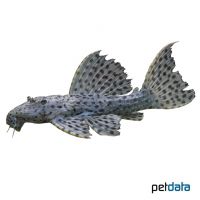Spiny Monster Pleco (Pseudacanthicus spinosus)
| Spiny Monster Pleco Pseudacanthicus spinosus | |
|---|---|
| Name | Spiny Monster Pleco |
| Name Lat. | Pseudacanthicus spinosus |
| Synonym | L96, L160 |
| Family | Suckermouth Armoured Catfishes |
| Family lat. | Loricariidae |
| Order | Catfishes |
| Order lat. | Siluriformes |
| Origin | Brazil |
| Habitat | Tributaries, forest streams |
| Diet | Carnivore |
| pH | 5.5-7.5 |
| Behavior | Nocturnal, territorial |
| Keeping | Individual, group |
| Care Level | Difficult |
| Reproduction | Cave spawner |
| Breeding | Difficult |
| Life Span | 8-12 years |
| Protection | No |
| Metric Units | |
| Size | 25-30 cm |
| Temperature | 24-28 °C |
| Hardness | 2-20 °dH |
| Aquarium | ~ 400 l |
| US Units | |
| Size | 10"-12" |
| Temperature | 75-82 °F |
| Hardness | 36-356 ppm |
| Aquarium | ~ 100 gal |
Distribution and habitat
The spotted cactus catfishes are widely distributed in the tributaries of the Rio do Para and the Rio Tocantins (Brazil). There are some local color variations. They live in slow-flowing jungle streams and small rivers, where they are often found in deep, rocky places.
Maintenance
The aquarium should have robust planting, with hiding places such as stones, roots and caves and provide adequate swimming space. A substrate of round gravel, slightly dim light and a weak current is ideal.
No ammonia, ammonium or nitrite should be detectable, and the nitrate value should not exceed 100 mg/l. To ensure the water quality and oxygen content, a filter and heater adapted to the aquarium size is required, as well as lighting for the species-appropriate day-night rhythm of the animals.
Diet
They feed on animal food. The food supply consists of live, frozen and dry food. For a balanced diet, feed once a day with a high-quality, protein-rich dry food for loricariids (granules, pellets, chips, tablets) as well as zooplankton, mosquito larvae, shrimp, krill, snails, fish, crab and mussel meat (live or frozen).
Only feed as much as will be eaten within a few minutes. Regular and varied feeding promotes health and increases resistance.
Behaviour and compatibility
They are crepuscular and nocturnal. Especially older animals can behave very territorial within the species. Several animals should only be kept in large and richly structured tanks. They can be socialized with robust, not too small fish.
Basically, only compatible fish species with similar demands on water quality and water temperature may be socialized.
Sex dimorphism
Sexually mature males have a thickened first pectoral fin ray and more and longer odontodes (pointed skin teeth) than females.
Reproduction and breeding
There are isolated reports of successful breeding in the aquarium. They are cave breeders and the male does the brood care.
Important
When trapping, use the finest mesh nets possible to prevent the hard rays of the pectoral fins or the skin teeth (odontodes) from becoming caught on the bone plates, which can cause painful puncture wounds when touched.
The well-being of the fish should be checked regularly. Temperature should be checked daily, pH, hardness and nitrate levels at least every 14 days. Regular partial water changes are recommended, even when contaminant levels have not yet reached the upper limit. Sudden changes in water quality should be avoided. Newly introduced fish must be accustomed slowly to the water in the aquarium.
Further literature can be found in your pet store.
References
Text: Sylvia Hos; Image: petdata
Source: BMEL (1998): Tierschutzgutachten - Haltung von Zierfischen (Süßwasser); WERNER, LECHNER, SCHMIDT (2005): L-Welse, Bede Verlag; ENGELMANN (2005): Zootierhaltung - Tiere in menschlicher Obhut: Fische, Verlag Harri Deutsch
- Gemäß § 21 Abs. 5 Tierschutzgesetz idgF
